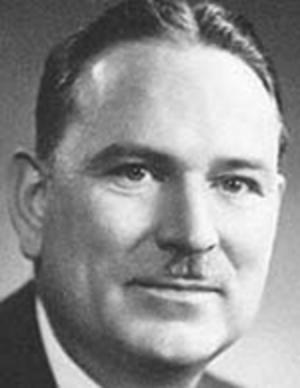A chemist and Illinois alumnus whose work was critical to U.S. operations in World War II has been inducted into the National Inventors Hall of Fame.
The late William Sparks (PhD, chemistry, ’36) had 145 patents to his name, but he’s best known for co-inventing poly-isobutylene-co-isoprene, more commonly known as butyl rubber, while conducting research at Standard Oil Company in 1937. Butyl rubber was critical to keeping the U.S. and its allies supplied with tires, rafts, boots, and other products during World War II when Japanese warships cut off shipments of natural rubber.
Sparks (1905-1976) and his co-inventor, the late Robert Thomas, were among 16 inductees recently admitted to the National Inventors Hall of Fame, located in Alexandria, Va. Beside the fact that Sparks graduated from Illinois, his honor has special significance on campus with his grandson, Robert Sparks, now attending Illinois as a doctoral student in biochemistry.
Robert recalls how his grandfather tested car emissions by placing a sock over a tailpipe, and how he tried to sell the president of Exxon (earlier called Standard Oil and Esso) on geothermal energy.
“He was very concerned about the environment,” Robert said, adding that his grandfather’s favorite quote was “Science without purpose is an art without responsibility.”
According to the Hall of Fame, Sparks and Thomas invented butyl rubber while experimenting with another Standard Oil product called Vistanex. They combined it with a small amount of butadiene in a washing machine.
“Smoke fill the air as the spin cycle finished, revealing the pair’s first commercial batch of butyl rubber,” the Hall of Fame reported. Butyl rubber turned out to be as strong as natural rubber, resistant to oxidation, and possessing unusually low gas permeability. Beside its use in World War II, it was commercialized in 1943.
Butyl rubber’s qualities make it useful for protective gloves, sealants, adhesives, tire inner tubes, bladders in sporting balls, and more. It’s good for dampening vibrations, exhibits good flexibility, resists weathering effects, and can become quite cold without becoming brittle.
There are several connections between the Sparks family and Illinois. Robert’s father, who earned a degree in biochemistry at the Massachusetts Institute of Technology, was taught by the son of Carl Shipp “Speed” Marvel, an Illinois professor who was considered one of the world’s most outstanding organic chemists. Marvel was Williams Sparks’ doctoral advisor.
Robert’s grandmother—Meredith, the wife of William—earned a doctoral degree in organic chemistry at Illinois under Roger Adams, for whom Roger Adams Laboratory is named.
Sparks, born in Wilkinson, Ind., earned his bachelor’s and master’s degrees from Indiana University before coming to Illinois for his doctoral work. He worked at Standard Oil, which became Esso and then Exxon, before a year-long stint at the Department of Agriculture’s Northern Regional Research Lab. He returned to Esso and remained at the company until his retirement in 1967.
Some of his other patents included new fuels, gasoline additives, propellants, encapsulated oxidants, asphalt additives, and food-wrapping films.
Others from Illinois who have been inducted into the National Inventors Hall of Fame include the late Arnold Beckman, (BS, ’22, chemical engineering, and MS, ’23, physical chemistry), for inventing the pH meter, and the late Paul Lauterbur, Illinois professor of chemistry, who won the Nobel Prize in 2003 for his pioneering work in the development of magnetic resonance imaging.
Dr. Sparks was the holder of 145 patents. He was honored during his lifetime with the American Institute of Chemists Gold Medal (1954), Charles Goodyear Medal (1963, for the functionality of elastomers), and the Priestley Medal (1965). He also served as president of the American Chemical Society in 1966.
Excerpted from LAS article by Dave Eversen
